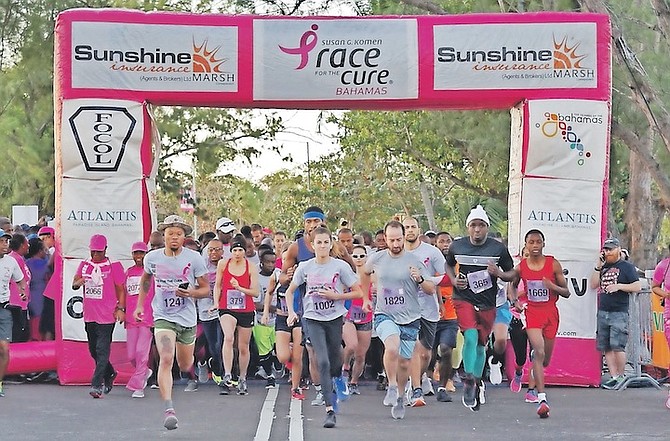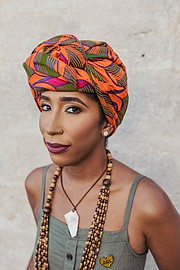THE BAHAMAS raises awareness in different ways when it comes to breast cancer - from T-shirt days and office events to larger scale days like the Race for the Cure, such as this one in 2019.
OCTOBER is Breast Cancer Awareness Month, so pink ribbons and pink t-shirts abound, especially on Fridays when many businesses have a casual day and encourage employees to support the cause.
The Bahamas has the highest rate of BRCA gene mutations which indicate a higher risk of breast cancer and ovarian cancer. In The Bahamas, women are diagnosed 20 years younger than the world average, and often with later stages of the disease. For this reason, we need to adjust our screening recommendations. Bahamian women need to start annual breast screenings by the age of 40. Those with a family history of breast or ovarian cancer need to start even earlier.
While some doctors recommend early screening for those at higher risk, there can be pushback from those in diagnostic centres and radiology departments. Earlier this year, I went for my first mammogram. While I tested negative for the known BRCA gene mutations in The Bahamas, my known family history prompted me to begin screening beyond my self-tests. When I booked the appointment, I was asked for my age. When I presented for check-in, I was questioned about my need for a mammogram at my age. I gave a brief overview of my family history and a second staff member seemed to tell the person I was speaking with to go ahead and check me in.
I had heard different stories about mammograms, but I was not worried about pain or discomfort. Fortunately, I did not experience either. The technician was pleasant and communicative and the mammogram was done quite quickly. It is important to know that mammograms do not always show everything. In fact, they can be difficult to read. In my case, it was very difficult to read and I was advised to have an ultrasound. I wondered if the issue was really dense tissue making it difficult to read the mammogram, or if they saw something and needed to confirm it or have a closer look. I was able to return later on the same day for the ultrasound.
The ultrasound, of course, took a longer time. I was bracing myself for the cold gel, but it was closer to room temperature than I had expected. The technician was very quiet, except to tell me when I needed to move or she needed to make an adjustment. There was no small talk, and there was no explanation of what she was doing. I was aware that she was moving the device around, typing on a keyboard, and capturing images. Because it takes a longer time, images are being captured, and the technician is focused (as they must be), it can be quite easy for thoughts to spiral. I was particularly aware that I needed to control my thoughts because this was my second exam for the day, and I was not completely sure why I had to do the second one, at a much higher cost. I chose to focus on my breathing, ignore the images on the screen that I could not interpret anyway, and wait to get the results from my doctor.
After not hearing from my doctor, I called the doctor’s office to inquire about my results. They had not received them, though I had requested that the result be sent directly to the office.
After a few phone calls, we got the results to my doctor. I was called in for an appointment and, again, I was not sure what this meant. Would they have given me normal or good results by phone?
I told my parents, who were aware that I was having these tests done, and they were both supportive. I was fortunate to have them both waiting for me when I left the appointment with my doctor. He had shown me the images and findings and advised me of next steps. I was glad to be able to immediately share this with my parents who at least pretended to be calm.
I decided to take the next step in another country. There, doctors were perplexed by my decision to have a mammogram at my age. One even suggested that mammograms are a scam. Though I was quite surprised by his statement, I firmly told him that I take my health seriously and, given my family history and the prevalence of breast cancer in The Bahamas, I chose to have a baseline mammogram.
When seeking healthcare in another country, which we do for many reasons, we have to consider not only cultural differences, but also the health norms and statistics that differ. What is unusual in one country is the way it’s done in another. I immediately realised that the doctor I was speaking with had no idea that The Bahamas has the highest prevalence of BRCA gene mutations, and I decided that he would not make me question my decision to ensure that I have all the information I need to make the best health decisions for myself. All I needed from him was a referral.
It was a bit of a run around, but with the support of my partner, I eventually went for another ultrasound, as recommended by my doctor within a certain timeline.
The technician was curious about my decision to have a mammogram and ultrasound at my age. I, again, explained that family history and national prevalence led me to get started early. I received the results and the comparison to the first one on the spot, and was advised to have another ultrasound in two years. It was good news, and I was happy to have it done.
When I worked on the BRCA gene testing in The Bahamas, it was challenging to get women to take the genetic test. Even when we told people the same test we were offering completely free of charge would cost over $3000 anywhere else, there was reluctance.
People were not sure that they were ready to hear their results. Their minds were already at a much later stage, focused on what they would do — or what they would have the resources to do — if the results were positive.
The genetic counsellor helped with this and explained that they would be guided through the process and provided with options. Still, it was not an easy decision. The same is true for mammograms and ultrasounds. Fear can drive us to take action, and it can stop us from taking action.
For me, it is easier to go through life with the information that will help me to make the best decisions with what is available to me.
This month, it is a bit easier to get a mammogram. The Breast Cancer Awareness Month specials have started, making this the best time of the year to get your mammogram. If you are advised to get an ultrasound, try not to panic. It does not necessarily mean anything is wrong.
Mammograms are not the best diagnostic tool for all breasts. Ultrasounds, however, are not cheap. Even if you have to put it off for a few weeks or months, at least you have your baseline mammogram.
If you are concerned about managing anxiety until you are able to pay for an ultrasound, remember that you can ask questions. Ask if the ultrasound is urgent. Ask if any portion of it can be covered by your insurance. Ask if there is a payment plan. Ask any questions that can help you to take care of yourself. If you haven’t already done it, call and make your appointment.
We’re already almost halfway through the month, and there are only so many appointments available. Make sure one of them is yours.






Comments
Use the comment form below to begin a discussion about this content.
Sign in to comment
Or login with:
OpenID